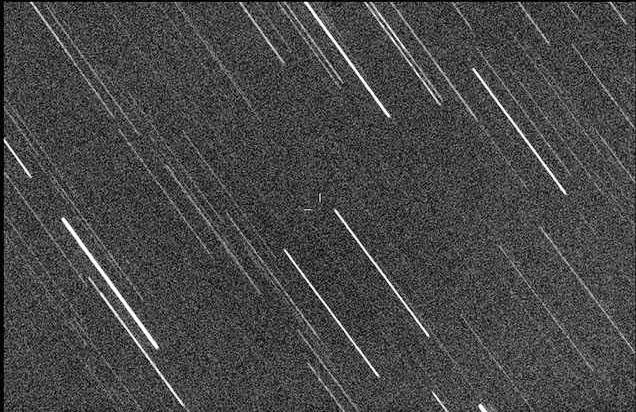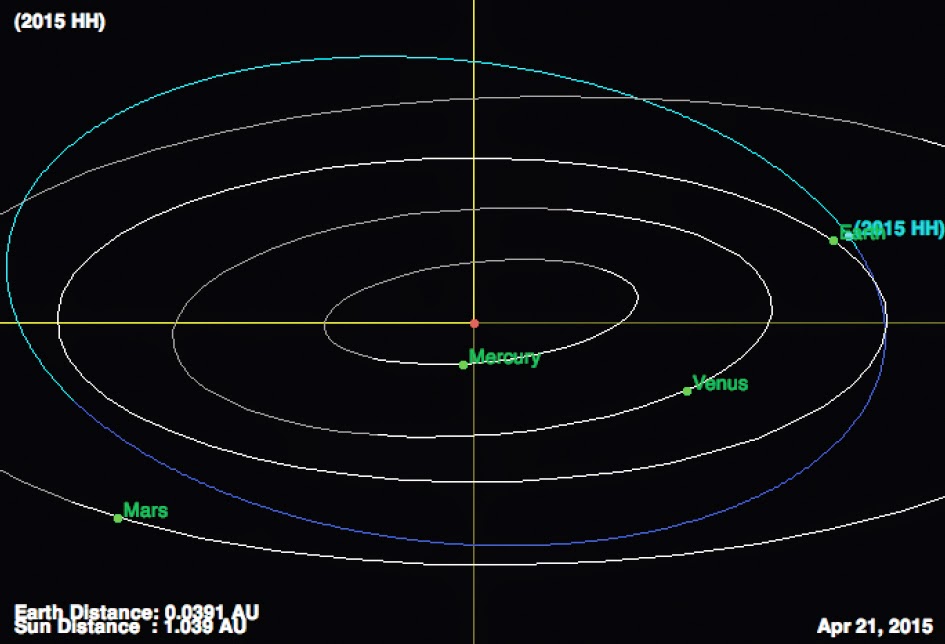Asteroid
2015 HT10 passed by the Earth at a distance of 627 100 km (1.63 times
the average distance between the Earth and the Moon, or 0.42% of the
average distance between the Earth and the Sun), at about 4.55 am
GMT on Wednesday 29 April 2015. There was no danger of the asteroid
hitting us, though had it done so it would have presented only a minor
threat. 2015 HT10 has an estimated equivalent diameter of 9-30 m (i.e.
it is estimated that a spherical object with the same volume would be 9-30 m in diameter), and an object of this size would be expected to
explode in an airburst (an explosion caused by superheating from
friction with the Earth's atmosphere, which is greater than that caused
by simply falling, due to the orbital momentum of the asteroid) in the
atmosphere between 32 and 16 km above the ground, with only fragmentary
material reaching the Earth's surface.
Image of 2015 HQ11 taken on 28 April 2015 from Ceccano in Italy. The
asteroid is the point in the
center of the picture. The longer lines are stars, their elongation
being caused by the telescope traking the asteroid over the length of
the exposure, in this case 120 seconds. Gianluca Masi/Virtual Telescope.
2015 HT10 was discovered on 21 April 2015 (eight days before its closest approach to the Earth) by the Dark Energy Camera on the Blanco 4-meter Telescope
at the Cerro Tololo Inter-American Observatory in La Serena, Chile. The
designation 2015 HT10 implies that it was the 269th asteroid (asteroid T10 ) discovered in the secondt half of April 2015 (period 2015 H).
2015 HT10 has
an 1080 day orbital period and an eccentric orbit tilted at an angle of 4.59° to the plane of the Solar System, which takes it from 0.88 AU from
the Sun (i.e. 88% of the average distance at which the Earth orbits
the Sun) to 3.24 AU from the Sun (i.e. 324% of the average distance at
which the Earth orbits the Sun, somewhat greater than twice the distance at
which the planet Mars orbits the Sun). It is therefore classed as an
Apollo Group Asteroid (an asteroid that is on average further from the
Sun than the Earth, but which does get closer). This also means that
close encounters between 2015 HT10 and the Earth are quite common, with
thenext predicted for April 2018.
See also...
 Asteroid 2015 HQ11 passes the Earth. Asteroid
2015 HQ11 passed by the Earth at a distance of 490 100 km (1.27 times
the average distance between the Earth and the Moon, or 0.33% of the
average distance between the Earth and the Sun), slightly before 6.20 am
GMT on Saturday 25 April...
Asteroid 2015 HQ11 passes the Earth. Asteroid
2015 HQ11 passed by the Earth at a distance of 490 100 km (1.27 times
the average distance between the Earth and the Moon, or 0.33% of the
average distance between the Earth and the Sun), slightly before 6.20 am
GMT on Saturday 25 April...
Asteroid
2015 HH passed by the Earth at a distance of 4 513 000 km (11.7 times
the average distance between the Earth and the Moon, or 3.02% of the
average distance between the Earth and the Sun), slightly after 10.25 am
GMT on Tuesday 14 April 2015. There was...
 Lyrid Meteor Shower to peak on 22-23 April this year. The
Lyrid Meteors will be at peak visibility between 22 and 23 April this
year, shortly after the New Moon on 19 April, which should ensure a good
display in areas with clear skies. The meteors, which appear to radiate...
Lyrid Meteor Shower to peak on 22-23 April this year. The
Lyrid Meteors will be at peak visibility between 22 and 23 April this
year, shortly after the New Moon on 19 April, which should ensure a good
display in areas with clear skies. The meteors, which appear to radiate...
Follow Sciency Thoughts on Facebook.


